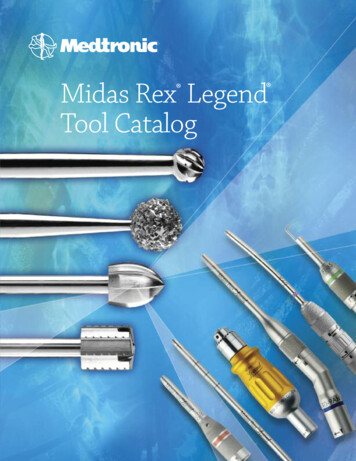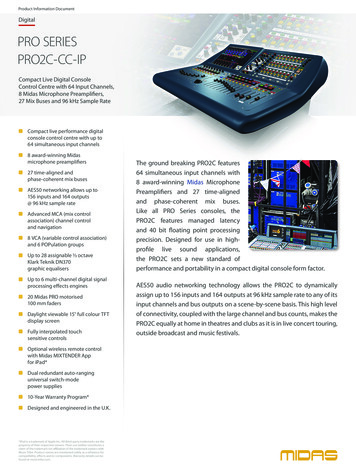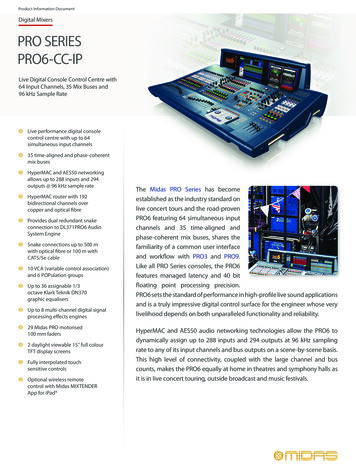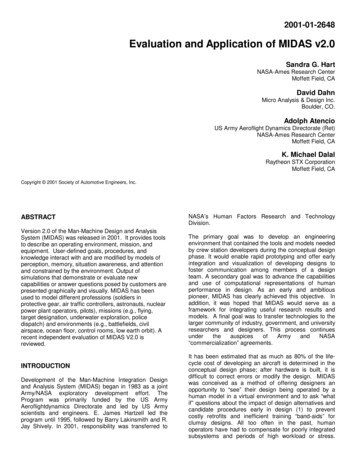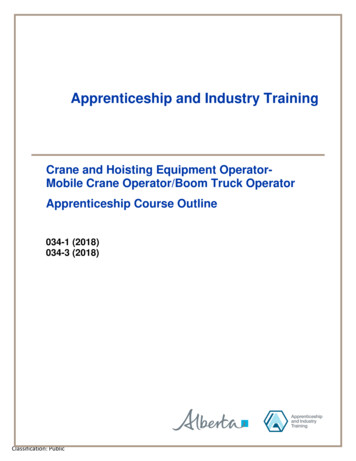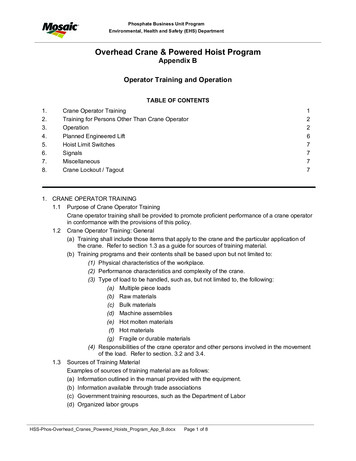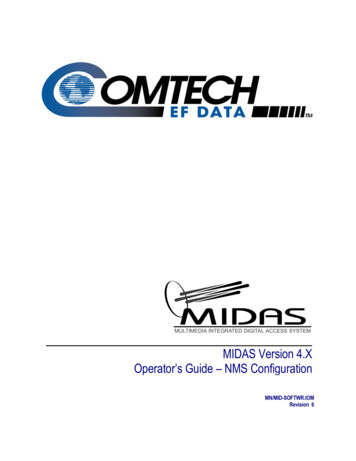
Transcription
MULTIMEDIA INTEGRATED DIGITAL ACCESS SYSTEMMIDAS Version 4.XOperator’s Guide – NMS ConfigurationMN/MID-SOFTWR.IOMRevision 6
MULTIMEDIA INTEGRATED DIGITAL ACCESS SYSTEMMIDAS Version: 4.XOperator’s Guide – NMS ConfigurationComtech EF Data is an ISO 9001Registered Company.Part Number MN/MID-SOFTWR.IOMRevision 6August 10, 2002Copyright Comtech EF Data, 2000. All rights reserved. Printed in the USA.Comtech EF Data, 2114 West 7th Street, Tempe, Arizona 85281 USA, (480) 333-2200, FAX: (480) 333-2161.
Network Customer SupportThe Network Customer Support Plan identifies the steps to be followed in resolving theCustomer’s concern.The resolution efforts will follow these levels of contact: Level One Contact – Factory Authorized Service Center.Level Two Contact – Comtech EF Data Customer Support.Level Three Contact – Network Test and Field SupportProcedural StepsStep1ProcedureThe Customer raises a concern with the Level One Contact.2The Level One Contact will perform Hardware repairs and Network Operationstroubleshooting in accordance with the Comtech EF Data Service Centeragreement.3If the Level One Contact is unable to resolve the concern, then the Level OneContact will inform the Level Two Contact of the concern in accordance with theinstructions found within the attached Comtech EF Data Customer SupportDepartment’s document.4The Level Two Contact will enter the concern into the Comtech EF Data databaseand determine whether the concern is a Hardware concern or a NetworkOperations concern5The Level Two Contact will interface with the Level One Contact and providethe appropriate hardware support and enter all correspondence into the Comtech EFData database.6If the Level Two Contact determines that the concern is a Network Operationsconcern, then the Level Two Contact will inform the Level Three Contact.7The Level Three Contact will interface with the Level One Contact and providethe appropriate support and enter all correspondence into the Comtech EF Datadatabase.8If the Level Three Contact determines that there is a Hardware failure then theLevel Three Contact will inform the Level Two Contact. Go to Step 5.MIDAS 4.X NMS Configuration, Rev. 6Preface,ii
Network Customer Support PlanCustomerYesMidas Network is functioningproperly?*Note: If equipment was purchaseddirectly from Comtech EFData (notthrough a Factory AuthorizedService Center), then CEFDCustomer Support will be the initialpoint of contact.NoLevel One Contact is notifiedAuthorized Factory ServiceCenterYesResolved by Hardware repairor Network Operationstroubleshooting?NoLevel Two Contact is notifiedCEFD Customer SupportHardware or NetworkOperations issue?HardwareCEFD Customer Supportprovides HW supportHardwareNetworkOperationsLevel Three Contact is notifiedCEFD Network Test and FieldSupportCEFD Network Test and FieldSupportprovides Network OperationssupportHardware or NetworkOperations issue?MIDAS 4.X NMS Configuration, Rev. 6Preface,iii
See the Comtech EF Data website at http://www.comtechefdata.com for contactinformation for a Factory Authorized Service Center. Contact the Factory AuthorizedService Center for: Product support Information on upgrading or returning a productContact the Comtech EF Data Customer Support Department for: Product support or trainingInformation on upgrading or returning a productA Customer Support representative may be reached at:Comtech EF DataAttention: Customer Support Department2114 West 7th StreetTempe, Arizona 85281 USA480.333.2200 (Main Comtech EF Data Number)480.333.4357 (Customer Support Desk)480.333.2500 FAXor, E-Mail can be sent to the Customer Support Department at:service@comtechefdata.com1. To return a Comtech EF Data product (in-warranty and out-of-warranty) for repair orreplacement:2. Request a Return Material Authorization (RMA) number from the Comtech EF DataCustomer Support Department.3. Be prepared to supply the Customer Support representative with the model number,serial number, and a description of the problem.4. To ensure that the product is not damaged during shipping, pack the product in itsoriginal shipping carton/packaging.5. Ship the product back to Comtech EF Data. (Shipping charges should be prepaid.)MIDAS 4.X NMS Configuration, Rev. 6Preface,iv
Contact the Comtech EF Data Network Test and Field Support for: System level Network Operations supportInformation on upgrading Network Operation softwareReporting comments or suggestions concerning manualsA Network Test and Field Support representative may be reached at:Comtech EF DataAttention: Network Test and Field Support2114 West 7th StreetTempe, Arizona 85281 USA480.225.2200 (Main Comtech EF Data Number)480.333.2089 (Network Test and Field Support)480.333.8816 (After Business Hours - Network Test and Field Support)480.333.2161 FAXor, E-Mail can be sent to the Network Test and Field Support Department at:mailto:midasfss@comtechefdata.comContact us via the web at www.comtechefdata.com.MIDAS 4.X NMS Configuration, Rev. 6Preface,v
This page is intentionally left blank.MIDAS 4.X NMS Configuration, Rev. 6Preface,vi
Table of ContentsCHAPTER 1. INTRODUCTION TO MIDAS NMS . 1–1Introduction .1–1MIDAS Overview .1–2System Specifications .1–9Using MIDAS NMS .1–9Starting the System .1–10Main Window.1–10Menu Bar.1–11MIDAS Menu.1–13Fault Management Menu .1–14Configuration Management Menu .1–15Security Management.1–16CHAPTER 2. SETUP AND OPERATION . 2–1Introduction .2–1Initial System Settings.2–2Space Segment .2–9Display Options.2–17Control Channels.2–22LinkSync .2–29Defining the Network Elements.2–33System Hierarchy .2–33Sites.2–33Site Types .2–34Setting Power Level for Traffic Channels.2–35Nodes .2–39Channels.2–43Security .2–48Assigning Connectivity.2–56Point-to-Point Connections .2–56Point to Multipoint Data Connections.2–66Hunt Groups .2–67Directory Numbers.2–72MIDAS 4.X NMS Configuration, Rev. 6Preface,vii
CHAPTER 3. MIDAS REPORTS . 3–1Event Browser.3–2Completed Calls and Active Calls Report .3–4Control Channel Statistics Report .3–6Control Channel Statistics Indicators.3–7Resetting the Statistics.3–9Node – Channel Status .3–9Faults .3–12Summary Faults .3–13Channel Faults.3–13Channel Warning .3–13Node Faults .3–13Site Faults.3–14CHAPTER 4. MAINTENANCE MENU . 4–1Service Messages.4–1Export Billing Data.4–3Select the Export Range .4–3Specify the Export Path.4–4Exported Billing Data File Record Format .4–5Database Backup and Restore.4–7Security Database Backup.4–7Security Database Restore.4–8Controller Database Backup/Restore .4–10APPENDIX A. FREQUENCY TRANSLATIONS .A–1MIDAS 4.X NMS Configuration, Rev. 6Preface,viii
About this ManualThis manual is written for the system operator using the MIDAS software and theNetwork Management System (NMS) to configure and administer satellitecommunications network.Cautions and WarningsCAUTIONCAUTION indicates a hazardous situation that, if not avoided, may result inminor or moderate injury. CAUTION may also be used to indicate otherunsafe practices or risks of property damage.WARNING indicates a potentially hazardous situation that, if not avoided,could result in death or serious injury.WARNINGIMPORTANT indicates a statement that is associated with the taskbeing performed. .IMPORTANTMetric ConversionMetric conversion information is located on the inside back cover of this manual. Thisinformation is provided to assist the operator in cross-referencing English to Metricconversions.TrademarksWindows is a trademark of Microsoft Corporation.Other product names mentioned in this manual may be trademarks or registeredtrademarks of their respective companies, and are hereby acknowledged.MIDAS 4.X NMS Configuration, Rev. 6Preface,ix
Reporting Comments or SuggestionsConcerning this ManualComments and suggestions regarding the content and design of this manual will beappreciated. To submit comments, please contact the Comtech EF Data NetworkCustomer Support Department.DisclaimerComtech EF Data has reviewed this manual thoroughly in order that it will be an easy-touse guide. All statements, technical information, and recommendations in this trainingmanual and in any guides or related documents are believed reliable, but the accuracy andcompleteness thereof are not guaranteed or warranted, and they are not intended to be,nor should they be understood to be, representations or warranties concerning theproducts described. Further, Comtech EF Data reserves the right to make changes in thespecifications of the products described in this training manual at any time without noticeand without obligation to notify any person of such changes.If you have any questions regarding your equipment or the information in this manual,please contact the Comtech EF Data Network Customer Support Department.MIDAS 4.X NMS Configuration, Rev. 6Preface,x
MULTIMEDIA INTEGRATED DIGITAL ACCESS SYSTEM1. Introduction toMIDAS NMSMIDAS Overview1–2System Specifications1-9Using MIDAS1–9IntroductionThe intent of this section is to introduce the user with the MIDAS NMS terminology andthe general operating instructions for the MIDAS NMS.1. Prior to running the MIDAS Installation Program, ensure that allnecessary hardware configuration and interconnections have beencompleted, including the Software license key, in accordance with theMIDAS 4.X Software Installation Manual.2. Prior to running the MIDAS NMS, it is necessary to follow the InitialSystem Settings steps in Section 2, Setup and Operation.The Multimedia Integrated Digital Access System (MIDAS) is a sophisticatedpower and transponder bandwidth management system for digital satellitecommunication networks. The Network Management System (NMS), runningMIDAS software, Version 4.X, provides the signaling and control elementsfor the network, manages power, transponder bandwidth, and circuits on ademand basis. Together, MIDAS and the NMS manage and allocate satellitenetwork resources efficiently and cost effectively.The MIDAS software is distributed throughout the network with elementsresiding within each MIDAS 1000 series control channel modem, providingcost-effective scalability of the network. Portions of the MIDAS software alsoreside on the network controller and operator workstation, providingcentralized control of power and transponder bandwidth, and permittingenhanced features such as circuit priority and preemption.MIDAS 4.X NMS Configuration, Rev. 6Introduction to MIDAS NMS 1–1
MIDAS software provides a graphical user interface(GUI) for network management functions. UsingMIDAS, the operator configures, modifies, controls,and monitors the elements in the satellite network. Thesoftware provides: Graphical views of network statisticsInput and maintenance of database informationPassword-secured access to system functionsand dataMIDAS OverviewIt is helpful to understand the basic description of a MIDAS satellitecommunications network and the NMS before proceeding with theexplanation of the MIDAS operating instructions.MIDAS services include: Circuit RestoralHunt GroupsPriority Assignments and PreemptionBandwidth Pools (Public or Private Pools)Predefined Point-to-Point (P-P) and Point-to-Multipoint (PMP) BroadcastData and VideoOn-Demand PMP Symmetrical or Asymmetrical Return ChannelAssignmentsRemote Site Initiated CallsFull Mesh Circuit CapabilityNMS SiteThe NMS site hosts the combination of computers, printers, software, andsatellite modems responsible for managing the entire satellite communicationsnetwork.The NMS site could also have one or more traffic-carrying nodes sharing theRF equipment with the NMS. A node, if located with the NMS, stillcommunicates with the NMS over the satellite.MIDAS 4.X NMS Configuration , Rev. 61–2Introduction to MIDAS NMS
NMS ComponentsThe NMS consists of the following:Controller ServerThe NMS Server is a Pentium -based computer that also hosts the networkdatabase. The NMS server functions include: Network configuration maintenance (of both static and dynamicinformation)Bandwidth and power managementCircuit managementNetwork monitoring and controlAutomatic Frequency Control (AFC)The NMS Server also maintains an extensive log of all network events:Call detail records can beexported for offline billing. Call detail recordsAlarmsSystem eventsNMS ServerThe operator workstation is a Pentium desktop computer with the MicrosoftWindows NT operating system and the MIDAS software (the GUI).Remote NMS Workstations are available, as an option.Network Control ModemThe SNM-1001 Network Control Modem allows communication of callcontrol and network management messages with the remote nodes over thecontrol channels. The modem transmits on the outbound control channel to theremote nodes and receives the incoming messages from the remote nodes onthe inbound control channel.For detailed information on the network control modem, refer to theSNM-1001 Network Control Modem Operation and Maintenance Manual.LinkSync ModemThe SNM-1002 LinkSync Modem monitors the outbound control channelat the NMS site. The outbound control channel is used as the frequency andpower reference for LinkSync calculations.MIDAS 4.X NMS Configuration , Rev. 6Introduction to MIDAS NMS 1–3
LinkSync is a unique MIDAS feature that provides:Automatic Frequency Control (AFC)The AFC process compensates for earth station frequency drift due tohardware aging and/or other factors, reducing the frequency uncertainty forcontrol and traffic channels. This compensation allows for faster call setup andtighter carrier placement.Uplink Power Control (UPC) at the NMS siteThe UPC process dynamically adjusts the transmit power for the outboundcontrol channel, thereby allowing a constant power level to be received by thedownlink from the satellite. This adjustment makes it possible for theoutbound control channel to be used as a reference.Circuit DisruptionMIDAS supports a family of single-channel traffic nodes using combinedcontrol channel and traffic modems, such as the SNM-1010/1010L. Thesenodes communicate on the control channel when no data circuit is active, andreprogram themselves to become a traffic modem when the circuit is activated.In the event that the network, or the network operator, needs to terminate orpreempt a circuit between two of these nodes, the LinkSync modem is used togenerate a carrier that forces the two nodes to lose carrier lock. This circuitdisruption causes the two nodes to reprogram themselves as control channelmodems and resume communication with the NMS.MIDAS 4.X NMS Configuration , Rev. 61–4Introduction to MIDAS NMS
Standard ControllerServer FeaturesFeatures of the MIDAS Controller Server include: Network configuration and administration: Network monitoring and control Network data collection and processing Circuit setup, termination, and scheduling Call detail recording Printable logs and reportsBandwidth and power management: C-band or Ku-band operation Bandwidth and power allocation on demand Dedicated bandwidth pools Configurable channelization and carrier spacing LinkSync AFC and UPC Support 70/140 MHz and L-band modemsOptionsMIDAS options include the following:RedundancyLocally Redundant Controller Server with automatic switch-overRedundant Network Control ModemCircuit Power ManagementRedundant LinkSync ModemSite-level call blocking ensures that a node does not transmit at a powerlevel beyond the capacity of the RF Amplifier. The system blocks circuitsetup if the total utilized power exceeds the power (less backoff) of thepower amplifier at that site, resulting in improved system stability.For detailed information on the SNM-1002 LinkSync Modem, refer tothe SNM-1002 LinkSync Modem Operation and Maintenance Manual.MIDAS 4.X NMS Configuration , Rev. 6Introduction to MIDAS NMS 1–5
Controller ServerRedundancyIn an optional 1:1 redundant configuration, the backup Controller Servermonitors the active Controller Server and the RF chain.If a failure is detected in the active Controller Server or the RF chain, thebackup NMS assumes the active role. If required, the Controller Serveroperator can command a switchover manually.Active and backup Controller Server(s) synchronize the databases on the LANover a dedicated circuit.Optional 1:1 redundancy for the Network Control Modem or the LinkSync Modem is provided via Comtech EFData's SMS-301 Redundancy Switch.Within 20 milliseconds of a detection of a fault in the online modem, theSMS-301 switches to the backup modem.The SMS-301 switch must be configured as remote address 1 running at EIA232, 19.2 kbps. Modem A and Modem B must have remote addresses 2 and 3,respectively. Those modems must be configured at 9600 bit/s. (EIA-485, 2wire, Even). For detailed information on the SMS-301 switch, refer to theSMS-301 Redundancy Switch Installation and Operation Manual.MIDAS 4.X NMS Configuration , Rev. 61–6Introduction to MIDAS NMS
NodeA MIDAS network node: Provides the interface for user trafficManages local resources in cooperation with the NMSA node can be located at a remote site, or at the NMS site. Multiple nodes canbe located at a remote site and share the RF equipment. As stated previously,one or more nodes located at the NMS site can share the RF equipment.Node ComponentsA MIDAS node may consist of: SNM-1000 Node Control Modems, each controlling from 1 to 30 trafficmodemsSNM-1010/1010L Data Control Modem, which serves as both the nodecontrol modem and traffic modemNode Control ModemThe SNM-1000 Node Control Modem performs as a dedicated nodecontroller. At a traffic node, it provides the interface to the NMS and manageslocal resources under NMS control. It executes circuit setup and termination,provides local M&C and diagnostics, and reports call detail information to theNMS.The SNM-1000 can manage up to 30 data modems.For detailed information on the SNM-1000 Node Control Modem, refer to theSNM-1000 Node Control Modem Operation and Maintenance Manual.Data Control ModemThe SNM-1010/1010L Data/Control Modem provide both control and trafficfunctions, switching between the two modes as required. They are used at sitesthat require single-channel data connectivity.In control mode, the SNM-1010/1010L provides the interface to the NMS.The modulator (operating in burst mode) is tuned to the inbound controlchannel; while the demodulator (operating in continuous mode) is tuned to theoutbound control channel.To originate or receive a call, the SNM-1010/SNM-1010L switches to trafficmode. While carrying user traffic, the modem operates in continuous transmitand receive mode. It supports data rates from 2.4 kbps to 5.0 Mbit/s.MIDAS 4.X NMS Configuration , Rev. 6Introduction to MIDAS NMS 1–7
For detailed information on the SNM-1010/1010L Data/Control Modem, referto the SNM-1010/1010L Data/Control Modem Operation and MaintenanceManual.External Traffic ModemsTraffic requirements may be met by external traffic modems operating incontinuous mode.Traffic modems supported by the SNM-1000 include:Comtech EF Data SDM-100Comtech EF Data SDM-2020 DemodulatorComtech EF Data SDM-300/300AComtech EF Data CiM-550Comtech EF Data SDM-6000Comtech EF Data CDM-550Comtech EF Data SDM-8000Comtech EF Data CDM-550TComtech EF Data SDM-2020ModulatorComtech EF Data CDM-600For detailed information on the listed modems, refer to the applicable manuals.MIDAS 4.X NMS Configuration , Rev. 61–8Introduction to MIDAS NMS
SystemSpecificationsSpecificationRefer to the applicable Comtech EF Data Specifications or manuals for the PCand modem requirements:Controller Server:Specification – SP/ 8861Operator Workstation :Specification – SP/8860NMS Server :Specification – SP/9175ComponentManualsSNM-1000 Node Control Modem: MN/SNM1000.IOMSNM-1001 Network Control Modem: MN/SNM1001.IOMSNM-1002 LinkSync Modem: MN/SNM1002.IOMSNM-1010 Data/Control Modem: MN/SNM1010.IOMSNM-1010L Data/Control Modem: MN/SNM1010L.IOMUsing MIDAS NMSThe MIDAS software consists of menus and windows designed for systemconfiguration, system administration, and reporting functions.This section explains the general operating instructions for using the MIDASsoftware, including Starting and exiting the softwareWorking with the menus and windowsUsing the online help fileSubsequent chapters in this manual describe the configuration, administration,and reporting functions of the software in detail.MIDAS 4.X NMS Configuration , Rev. 6Introduction to MIDAS NMS 1–9
Starting the SystemFollow the following steps to Start the MIDAS software:1.Power up the Controller and the NMS Server.2.Wait for the Windows NT desktop to appear.3.Double-Click the Network Node Manager icon.Main WindowOnce valid Logon entries have been made, the Main window is displayed.The Main window contains the functional areas of MIDAS and HP OpenView.MIDAS 4.X NMS Configuration , Rev. 61–10Introduction to MIDAS NMS
Menu BarMIDAS menu bar is located on HP OpenView’s standard Windows menu bar,which provides access to several function-specific menus.To use the menu bar, proceed as follows:1.Click on the desired menu title to open the menu.2.Click on a menu option.or:1.Type Alt the underlined letter of the desired menu title.2.Use the Tab key to select a menu option.3.Press the Enter key.MIDAS 4.X NMS Configuration , Rev. 6Introduction to MIDAS NMS 1–11
ROOT MenuMIDAS 4.X NMS Configuration , Rev. 61–12Introduction to MIDAS NMS
MIDAS MenuLogin/Logout MenuThe Login menu will log a user into MIDAS, enabling them to access MIDASfunctions as defined in Security Management/Administration.The default Login User ID is ADMIN with a password of ADMIN.The Logoff menu will log a user out of MIDAS, enabling users to changedifferent usernames for different access preferences.MIDAS 4.X NMS Configuration , Rev. 6Introduction to MIDAS NMS 1–13
Fault ManagementMenuSummary Bar -Summary display of all events in MIDAS. Events selected willthen be viewed using Event Display.MIDAS 4.X NMS Configuration , Rev. 61–14Introduction to MIDAS NMS
Configuration Management MenuCAUTIONAlthough it is possible to open more than one section of any MIDAS menuwindow, the user should always ensure that only one instance of any particularmenu window is open at any one time to maintain optimum performance.Network Administration – Shows the specific information for that particular site, node orchannel. The enabling and disabling of sites, nodes and channels are also done here.Connection Administration – Define the connection table and details, to enable/disableconnections, define hunt groups and also
MIDAS software, Version 4.X, provides the signaling and control elements for the network, manages power, transponder bandwidth, and circuits on a demand basis. Together, MIDAS and the NMS manage and allocate satellite network resources efficiently and cost effectively. The MIDAS software is distributed throughout the network with elements


